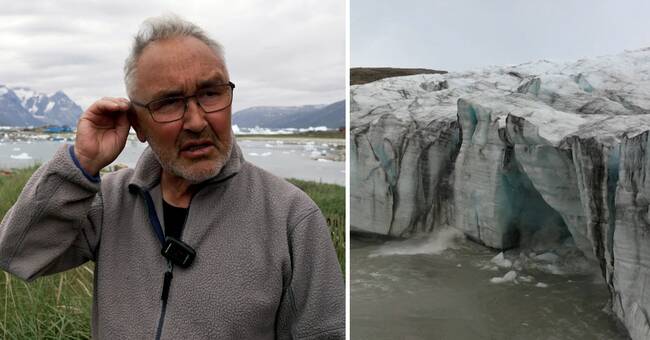We wade in the meltwater along the huge Russel Glacier and see with our own eyes how the huge ice sheet melts.
All around us we hear the sound of water rushing forward, under our feet the meltwater is bubbling in cracks in the ice.
The ice sheet, which is at least 100,000 years old, moves, is wrinkled, collapses, cracks and gets lower, it is gray from all the sand and gravel that thaws out of the ice.
It is like an ancient animal that is slowly fading away.
At the edges of the ice, we see how mudslides have progressed, an effect of the permafrost thawing.
Has retreated 300 meters
The fact that the melting ice is turning gray with sand and that more and more ground is becoming ice-free accelerates the melting, the so-called albeido effect, as dark surfaces mean that the sun's rays are no longer reflected out.
To get to the glacier, we went on one of the few roads in Greenland, built by a European car company that wanted to test drive their cars on the ice.
But the car company has abandoned the melting ice and the road is now barely passable.
Where the road ends abruptly, the ice sheet piles up, covering 80 percent of Greenland.
- In just 20 years, the Russel Glacier has retreated 300 meters, says Jörgen Lynge, nature guide in Greenland and points to the edge of the glacier.
- It has also become 100 meters lower in places.
Last week the warmest measured
Suddenly when we stand and look at the blue shimmering ice wall, a crash is heard.
It is the edge of the ice that erodes and drops part of the wall.
Waves form in the pools with meltwater before everything becomes still again.
The heat wave last week resulted in twice as high temperatures as normal.
On July 29 in northeast Greenland, 23.4 degrees was measured, which is the highest temperature since the measurements began.
The meltdown was admittedly somewhat larger in the summer of 2019, but this time it was a larger area that was affected.
8.5 billion tons of ice melted in one day.
The report comes from the Danish institute Polar Monitor, which compiles the measurements made in Greenland.
Heating can slow down melting
Glaciers also collapse around the coasts in the sea, those that helped keep the ice sheet in place.
In the fjords at Nuuk we get to cross between the icebergs, meltwater crashes down on the mountain sides.
But there are uncertainties in the researchers' climate models.
The warming can paradoxically benefit the ice sheet as more moisture and snow could slow down the melting.
One of the world's last untouched wilderness is changing and it is almost only the 56,000 residents of Greenland who know which values will disappear forever.
- It feels very sad, I have seen the rapid changes during my lifetime and I am only 28 years old, says Jörgen Lynge.

